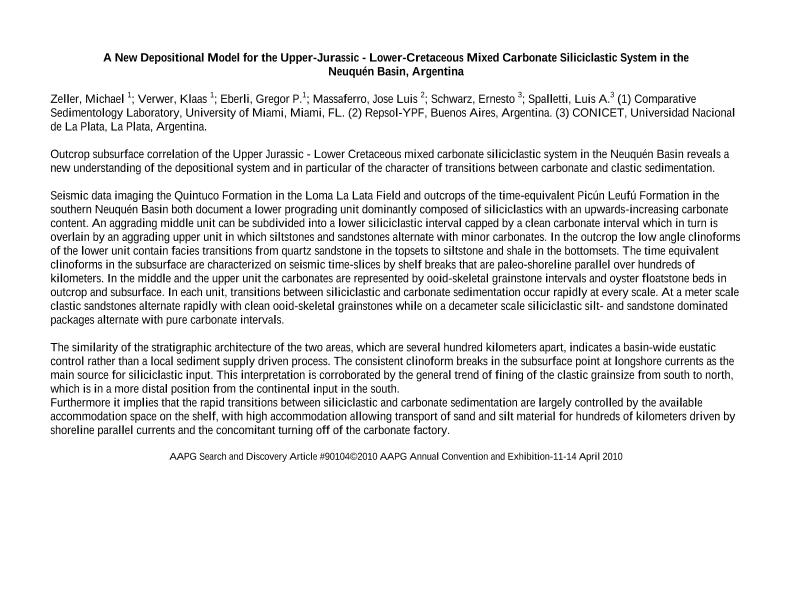Evento
A New depositional model for the Upper Jurassic - Lower Cretaceous mixed carbonate-siliciclastic system in the Neuquén Basin, Argentina
Zeller, Michael; Verwer, Klaas; Eberli, Gregor P.; Massaferro, José Luis; Schwarz, Ernesto ; Spalletti, Luis Antonio
; Spalletti, Luis Antonio
 ; Spalletti, Luis Antonio
; Spalletti, Luis Antonio
Tipo del evento:
Exposición
Nombre del evento:
AAPG Annual Convention and Exhibition
Fecha del evento:
11/04/2010
Institución Organizadora:
American Association of Petroleum Geologists;
Título del Libro:
AAPG Annual Convention and Exhibition, Abstracts volume
Editorial:
American Association of Petroleum Geologists
Idioma:
Inglés
Clasificación temática:
Resumen
Outcrop subsurface correlation of the Upper Jurassic - Lower Cretaceous mixed carbonate siliciclastic system in the Neuquén Basin reveals a new understanding of the depositional system and in particular of the character of transitions between carbonate and clastic sedimentation. Seismic data imaging the Quintuco Formation in the Loma La Lata Field and outcrops of the time-equivalent Picún Leufú Formation in the southern Neuquén Basin both document a lower prograding unit dominantly composed of siliciclastics with an upwards-increasing carbonate content. An aggrading middle unit can be subdivided into a lower siliciclastic interval capped by a clean carbonate interval which in turn is overlain by an aggrading upper unit in which siltstones and sandstones alternate with minor carbonates. In the outcrop the low angle clinoforms of the lower unit contain facies transitions from quartz sandstone in the topsets to siltstone and shale in the bottomsets. The time equivalent clinoforms in the subsurface are characterized on seismic time-slices by shelf breaks that are paleo-shoreline parallel over hundreds of kilometers. In the middle and the upper unit the carbonates are represented by ooid-skeletal grainstone intervals and oyster floatstone beds in outcrop and subsurface. In each unit, transitions between siliciclastic and carbonate sedimentation occur rapidly at every scale. At a meter scale clastic sandstones alternate rapidly with clean ooid-skeletal grainstones while on a decameter scale siliciclastic silt- and sandstone dominated packages alternate with pure carbonate intervals. The similarity of the stratigraphic architecture of the two areas, which are several hundred kilometers apart, indicates a basin-wide eustatic control rather than a local sediment supply driven process. The consistent clinoform breaks in the subsurface point at longshore currents as the main source for siliciclastic input. This interpretation is corroborated by the general trend of fining of the clastic grainsize from south to north, which is in a more distal position from the continental input in the south. Furthermore it implies that the rapid transitions between siliciclastic and carbonate sedimentation are largely controlled by the available accommodation space on the shelf, with high accommodation allowing transport of sand and silt material for hundreds of kilometers driven by shoreline parallel currents and the concomitant turning off of the carbonate factory.
Archivos asociados
Licencia
Identificadores
Colecciones
Eventos(CIG)
Eventos de CENTRO DE INVEST.GEOLOGICAS (I)
Eventos de CENTRO DE INVEST.GEOLOGICAS (I)
Citación
A New depositional model for the Upper Jurassic - Lower Cretaceous mixed carbonate-siliciclastic system in the Neuquén Basin, Argentina; AAPG Annual Convention and Exhibition; New Orleans; Estados Unidos; 2010; 1-1
Compartir



